Discover the delicate details and captivating artistry of Maria Sibylla Merian paintings & prints, showcasing the beauty of flora and fauna. All are in the Public Domain and free to print.
A collection of carefully curated Maria Sibylla Merian prints from her seminal book “Metamorphosis Insectorum Surinamensium”, the “Metamorphosis of the Insects of Suriname“. The book was published in 1705.
This was a seminal entomology book by the German naturalist and scientist. The book contains the most incredible drawings and paintings of insects’ lifecycles and the plants around them.
Who Was Maria Sibylla Merian
Maria Sibylla Merian (1647-1717) was one of the most important pioneers of entomology. One of the first naturalists to study insects, particularly their metamorphosis. She was famous for creating the most stunning illustrations and artwork of insect life cycles.
Amazingly, this was when most naturalists were still discussing “spontaneous generation”, the belief that insects spring forth magically from mud, waste and plant matter.
Merian’s depictions of metamorphosis were based on her meticulous observations of living creatures and the plants that sustained them.
Her entomology had an ecological aspect in that most of her insect art included paintings of the fruits and flowers the creatures lived off. They were dynamic illustrations based on living organisms rather than dried samples.

Maria’s works was so important, that her classification of butterflies and moths is still used today.
Her interest in insects began when she first bred silkworms as a child. Maria Merian published two books on caterpillars and European insects early in her career.
When she was 52, Maria travelled to Dutch Surinam in South America to study tropical insects, which was remarkable at the time, especially as a woman. She travelled with her daughter but without protection and funding. Maria Sibylla Merian sold her beautiful insect artwork to pay for her expedition.
Her expedition was also unusual for the time, as most exploration was for economical and political reasons and not a scientific endeavour. Maria complained that the Dutch in Suriname, were only interested in the country for its sugar cane when the country had so much more to offer.
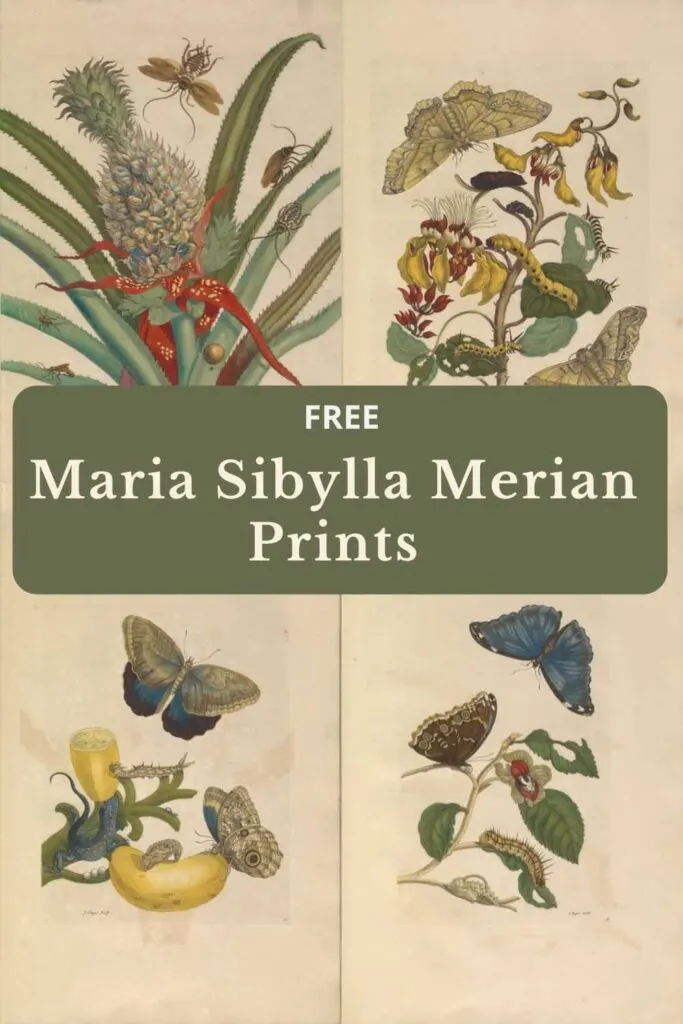
The Maria Merian Paintings
To download the Maria Sibylla Merian prints, click the title above the one you want. A higher-resolution image will open in a new browser on your device. If you right-click on that image you will have the option to save or print that particular insect artwork.
Merian’s Metamorphous Insect Prints 1-8
Merian describes cockroaches are the most well-known insects in America. This is because they are pests that cause harm and inconvenience for many, from spoiling wool, linen, food and drink.
Maria Merian used a pineapple drawing for the cockroach metamorphosis illustrations. The insects love sweet food and thus are very fond of this fruit.

2. Pineapple and Butterfly Life Cycle
Merian was disappointed that the Dutch in Suriname seemed to be only interested in the trade of sugar beets. She tried to get them interested in the other fruits the country had to offer, especially the pineapple.
This is how she described the fruit in her book, “Metamorphosis of the Insects of Suriname“:
“The taste of this fruit is as if one had mixed grapes, apricots, currant, apple, and pears in one, all of which are tasted equally in it. Its smell is sweet and strong, when you pick it up, the whole room smells like that. The crown and the leaves, which shoot to the side, are laid in the ground, which again became new plants, they grow as easily as weeds, needing six months young shoots, to its full maturity. One eats it raw and cooked, and wine and brandy can also be distilled and burned from it, both of which are delicious in taste and surpass all others.”
Maria Sibylla Merian
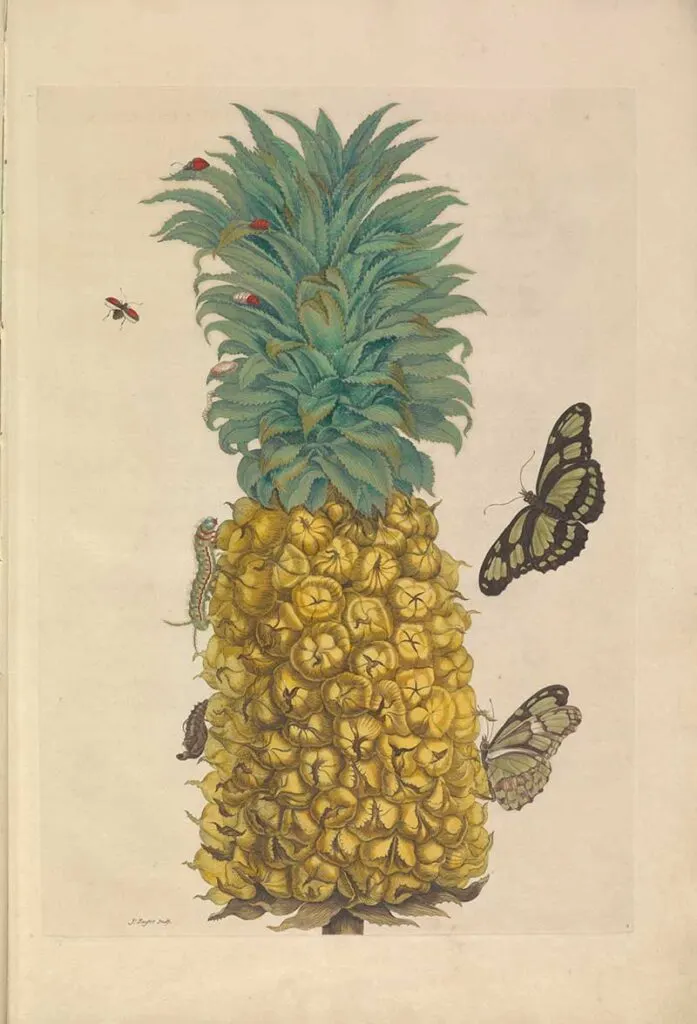
The fruit described in this illustration by its Dutch name Zuurzak is more commonly known as Soursop. It smells like pineapple and tastes like a combination of strawberries and apples with a hint of sour citrus. This contrast with the fruits’ thick creamy banana-like texture.
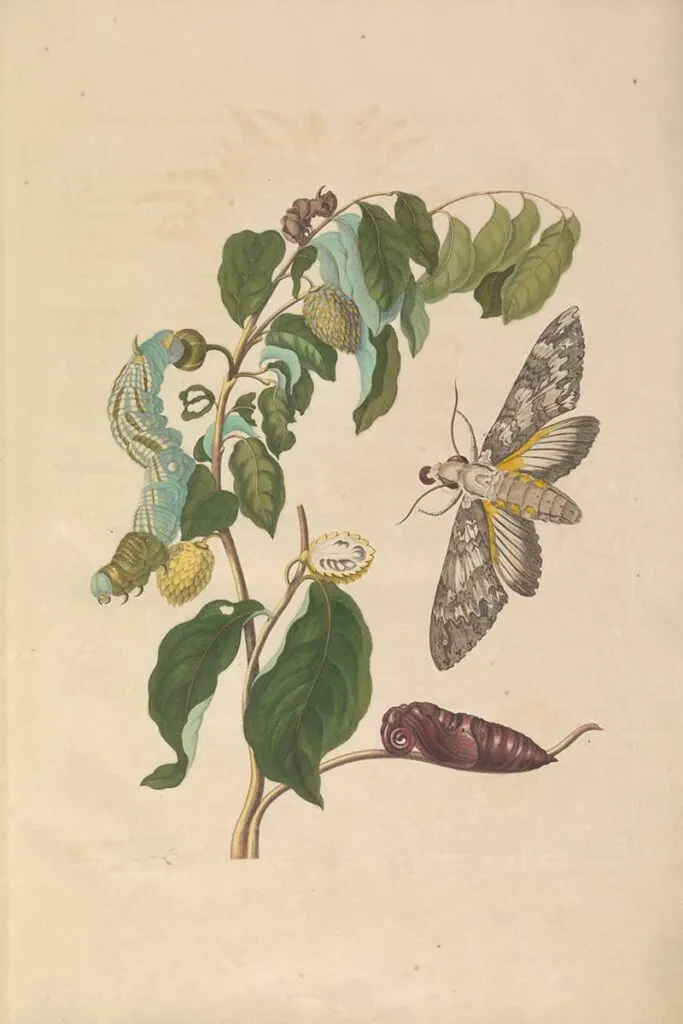
An American thistle is known as “Maccai“, with two different types of caterpillars and the corresponding moths.

5. Pomegranate and Butterflies
Maria didn’t have much to say about the pomegranate as they were already well known in Europe. But she did describe the blue butterfly as follows:
“This blue Capelle shows itself through the magnifying glass as blue tiles, being of the same shape as the tiles on the roofs, laying very orderly and regular, being broad feathers like the feathers of peacocks, of wonderful brilliance, well resistant to look, so which cannot be described.”
There are more pomegranate prints on the site with this antique watercolor fruit collection.
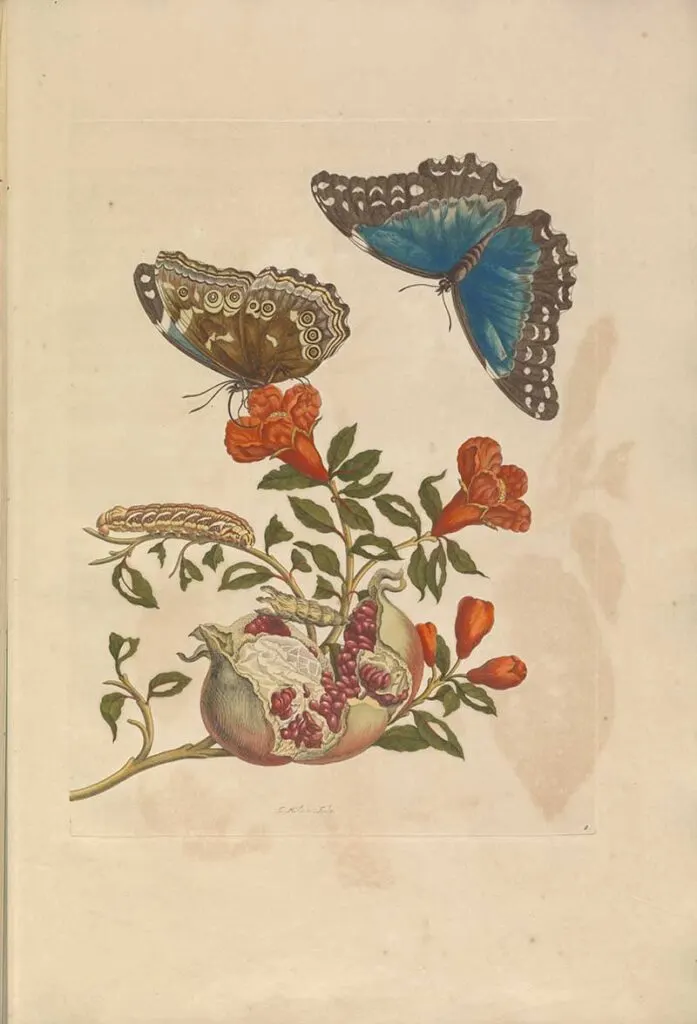
6. Pallisaden Tree and Caterpillars
Another Maria Merian print of the full lifecycle of the butterfly. These species with distinct yellow and black caterpillars.

7. Butterfly Metamorphosis on Banana Tree
“On this tree, I found this green caterpillar with whose leaves I spayed her until April 21, when her skin sheared off became a puppet, and the 10 May was transformed into such a beautiful owl.”

8. Butterfly Metamorphosis On A Watermelon
The text accompanying this Maria Sibylla Merian print describes the watermelon fruit as follows.
“These watermelons wash along with the earth, like in Holland the commoners, they have a hard shrill that gradually loses its hardness inside, the flesh is shiny, in the mouth it melts like sugar, is healthy and pleasant in taste, and is the cure of the sick. The inflorescence is small and inconsiderable, yellow in colour, the seed is red, and when it is overripe, it becomes black.”
There is a lovely watermelon painting in this collection of Asian fruit watercolours.

Maria Sibylla Merian Prints 9-16
9. Spiders and Ants on A Guava Tree
Some of the text accompaning this insect print describes the spiders and ants as follows:
“I have found a lot of animal-like large black spiders on the Guajaves trees, they dwell in such a round nest, as in the next leaf shows the spider of the caterpillar, they make no long threads, as some travellers have wanted to make wise, they are roundabout full of hair and have sharp teeth.”
“In America, there are very large ants, which can make whole trees bare like brooms in one night, they have two crooked teeth, which go over each other like shavings, with these they cut the leaves from the trees, and let them fall, that the tree become as in Europe the trees of winter, then are thousands of them from below, and carry them in her nests.”

“In April I was up to Suriname on the plantation of Miss Soomelsdyk, called Providentia, where I made several observations of insects, while walking I found a multitude of Gummi Gutta Trees in the wild, of which I here represent a branch he washes almost like the birch trees in Europe … On this tree, I found this great caterpillar of green and black stripes …. Before the caterpillar was changed, the green turned to red, that is, before she became a doll after she had reached her full greatness.“

11. Insect Metamorphosis on Red Lilies
“These red lilies wash on a white bulb in the wild, her quality is unknown, her green leaves have a brilliance like silk. I have brought some mead of the bulbs, they first produced her flowers in the courts of Holland, and thereafter her leaves.”
There are more lily drawings on the site.
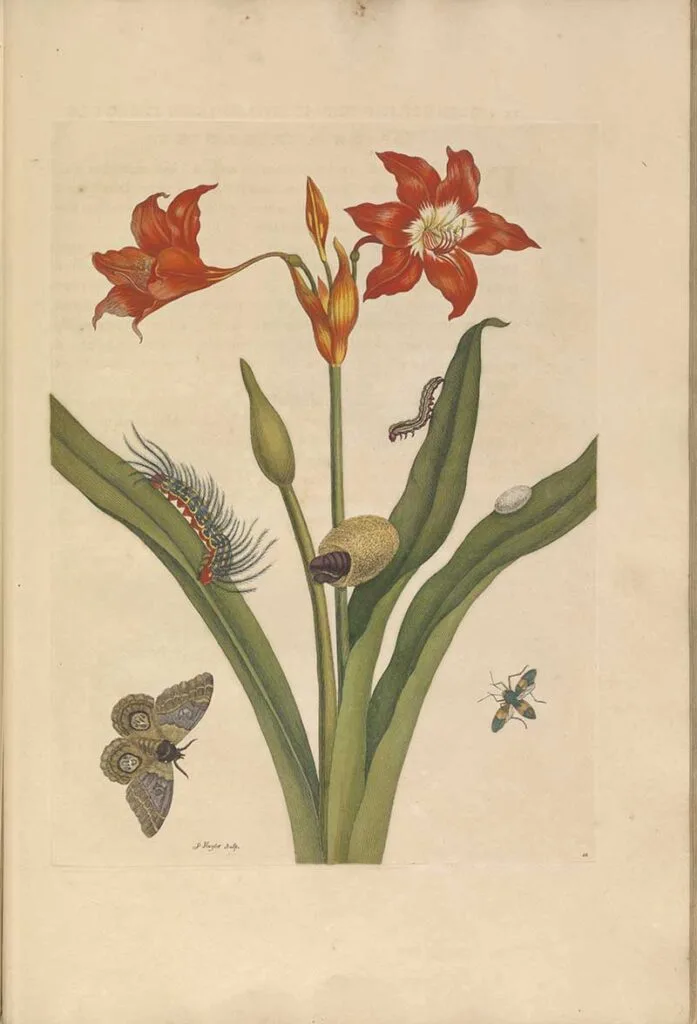
12. Lizard and Butterflies On Banana
“This yellow fruit is called Baccoves, and is a genus of Bannanes. This Baccoves is so soft in flesh, like the Bannanas, has a similar use to it, except that this fruit is used to make almost sour the Azyn, which is prepared from sugar and water.“
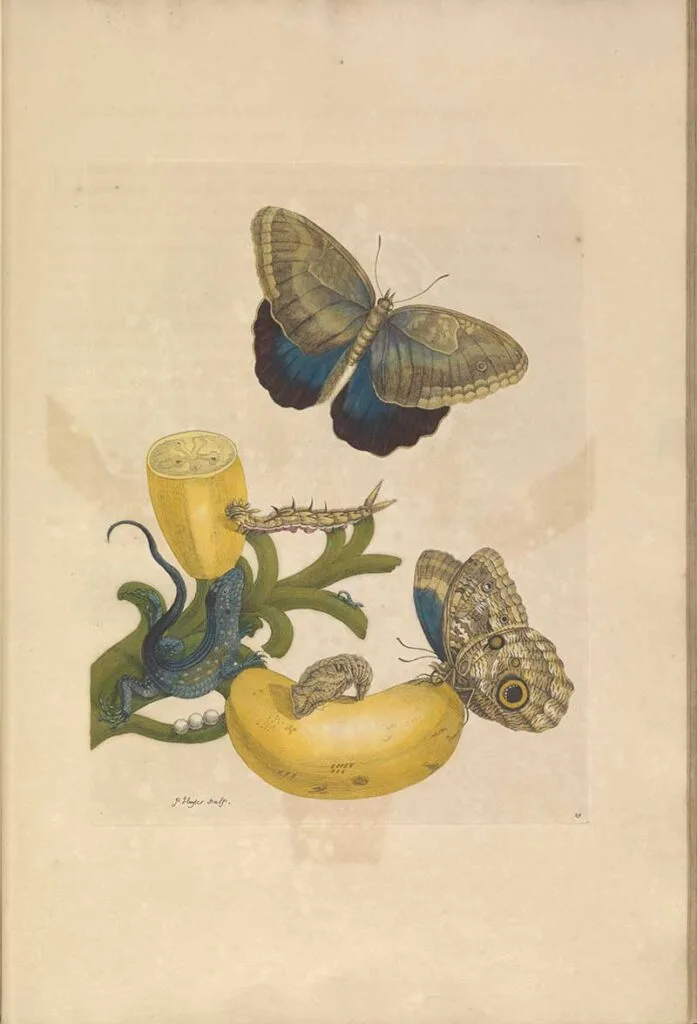
“These beautiful, largest lemons grow wild in Suriname, the trees are as tall as the largest apple trees in Europe, the leaves and blossoms are alike to the common Lemons in everything, except that they are larger and thicker in proportion to the fruits, which fruit inside little margin, but has a very thick skin.“
The insect on the lemon is unidentified but Maria noted that it was venomous.

This is one of Maria Sibylla Merian paintings of the metamorphosis of butterflies on flowers, this time the roses.
There are lots of botanical rose illustrations on the site too.

“I have found this plant in the wild as far as Suriname, grows eight feet high, has small dark red flowers, the seed-house was divided into three, in each division is a seed, which is green in the beginning, then brown, the green leaves are covered all around with small green fibers, each of which has a small bud, they are also boiled, and the water is given to those who have the Beljak (a certain land disease) to drink.”

“Muscus Flower grows on a plant about eight feet high, the flower is yellow, has no smell at all, when it has fallen off grows a large seed-house, full of brown seeds inside, which have a very strong musk smell. have. The virgins thread them on the side, and tie them around the arms to adorn themselves with them in their own way; the leaves use them to fatten the young calcoens.“

Maria Sibylla Merian Paintings 17-23
“A branch of a very tall tree waxing wild, fine leaves are hard and stiff, on the stems of the wood is a bush with round horns, which they use in the Medicine against the qualities of the Longe. This tree is called Marmalade-Doosies-Tree , because of the fruit which it produces, this fruit is shaggy and hairy on the outside, green at first, then yellow and hard: they cut it in the middle and eat the inside, which has much in common with the European Medlars, in taste, color and seeds, and the peel is like a box, wherefore it is called a Marmalade-doos.”

18. Peacock Flower and Insect Metamorphosis
Peacock flower (Flos Pavonis).

19. Pomegranate Tree and Lantern-Bearers
Maria Sibylla Merian print of pomegranate flowers and insects the locals called Lantern-Bearers.

“At a certain time I went into the wilderness and found among others a Tree, which the inhabitants call Medlar -Tree, the Tree grows very high, the fruit has formed in the midst a white crop like a deer, with black seeds thereupon it (which men eat for a Medlar) beneath it are two thick blood-red, and behind it five thick greenish leaves, lovely to look at.”

“This Plant, called Ballia by the Indians, washes in the Wood by the side of the swampy waters, four or five feet high, has hard green leaves like the reed, bears a red thick flower, the little buds are a little more subtle.”

“The flowers presented here I have found in standing waters, I did not see leaves there, the stem was an ell long, the flowers resembled themselves like violet crocus, each flower had a blue leaf with a yellow flat like the Iris has.“

“On this tree I found another species of hairy caterpillars, using the even foliage for their food, the hair of some was white, and some yellow, the skin of these caterpillars under the hair is like human flesh, they are very venomous like if one touches her with one’s hand, it immediately ignites, and there is a great filth there, as I have found, in the middle of the body they have four feet and go on all their limbs“

Other Entomology Paintings & Prints
I hope you enjoyed these stunning Maria Sibylla Merian prints. Don’t forget to check the site’s many other vintage natural history prints. These include antique insect prints, such as dragonfly drawings and vintage butterfly images.
You’ll find many more bulb flower prints in this collection of Renaissance Flowers.
John Curtis is also well known for painting insects with plants, mainly flowers. Check out his vintage entomology prints here.
Joris Hoefnagel is also famous for painting insects with fruits; check out this well-known natural history illustrated calligraphy prints of his. Also, another Dutch naturalist to check out is the nature sketches of Jan Brandes.
For some stunning insect, identification charts check out the natural history posters of Adolphe Millot.
If you fancy, you can Buy Me A Coffee Here.

Rebecca
Wednesday 9th of March 2022
Great prints. I love all of your vintage prints. Keep them coming.
claire
Wednesday 9th of March 2022
Thank you so much.